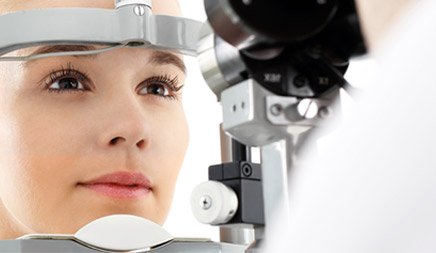WHAT DOES A CONSULTATION ENTAIL?
You will have a vision assessment that is appropriate for your age, your symptoms and your lifestyle.

HOW IS YOUR VISION?
Eyes Health Assessments – all ages
- Distance and near vision assessment
- Comprehensive internal and external eye health examination
- Digital Retinal Photograph to assist in detecting any serious eye disease including glaucoma, macular degeneration and retinal changes that may be associated with diabetes
- Identification of any problems with vision and consultation on preferred eye treatments

WE OFFER OCT SCANS
Optical Coherence Tomography
- Optical Coherence Tomography (OCT) lets us see the detailed structures below the surface of your eye
- Reveals hidden layers enabling us to accurately detect, monitor and manage changes in the retina
- The scan shows incredible detail
- Scan only takes minutes
- No contact with the eye, so no discomfort

CONTACT LENSES
Contact Lens – Diagnostic and Fitting
- Have an Eye Health Assessment
- Eye measurements are taken
- Various options are presented to you including lens materials, design and appropriate wear time
- Receive professional training on insertion, removal and care
- Follow up care to check for lens functionality and general surface eye health with contact lenses
- Contact Lens Consultation
- Glaucoma Eye Care
- Frame Fitting
- Cataract Consultation
- Children’s Consultation
- Laser Vision Correction Test
- Diabetes Eye Care
- Dry Eye Assessment
- Macula Degeneration Eye Care
 Eye Nutrition and recommendations We prescribe and recommend Macutec and Lacritec. These are Australian made eye supplements of the highest quality. All formulations offer the best protection for your eyes.
Eye Nutrition and recommendations We prescribe and recommend Macutec and Lacritec. These are Australian made eye supplements of the highest quality. All formulations offer the best protection for your eyes.

CONSULTING ROOM TECHNOLOGY
Our measures are precise and accurate.
DIGITAL RETINAL IMAGING
A digital image is taken of your retina, blood vessels and optic nerve to assist in the early detection and ongoing management of eye diseases, such as glaucoma, macula degeneration, diabetes and hypertension. It’s a painless test and takes a few minutes to complete.
OPTICAL COHERANCE TOPOGRAPHY – OCT (SOUTH YARRA LOCATION)
An OCT scan shows the inner most structures of the eye in 3D. It’s used for the early detection and management of eye diseases such as glaucoma and macula degeneration. OCT is the only procedure currently available that shows in-depth images of the eyes’ internal structures.
VISUAL FIELD TESTING (RICHMOND LOCATION)
This assessment is designed to check your central and peripheral vision. It’s used to: detect damage to the optic nerve from diseases like glaucoma; monitor glaucoma treatment; detecting problems with the visual pathway leading to the brain; to obtain a baseline for future comparison and assessing fitness to drive.
SOME COMMON EYE CONDITIONS
Most eye conditions can be corrected if caught early. Eyes are so important in determining how we live that it never ceases to amaze us how neglected they are!
Short Sightedness (Myopia)
This is a condition where you have trouble focusing on objects in the distance. With short-sightedness, you will likely experience blurred vision when trying to read street signs, or words on a whiteboard, watching television, playing sport and even difficulty recognising people walking towards you.
Astigmatism (Irregular shaped eye)
Most people don't have a perfectly shaped cornea. However an irregularly curved cornea can sometimes cause blurred vision. This is known as astigmatism. Common symptoms include eye strain, reduced concentration, fatigue, discomfort or distortion. Higher degrees of astigmatism can cause images to distort.
Glaucoma
Glaucoma is a disease that affects the optic nerve, preventing the flow of information from the eye to the brain resulting in permanent vision loss. It primarily affects people over the age of 40. People with Glaucoma may be unaware of any problems until vision loss has become severe, so early testing is encouraged.
Long Sightedness (Hyperopia)
Although your distance vision is good, you have trouble focusing on closer objects, which appear blurred. Other symptoms include eye fatigue, headaches and aching eyes, especially after reading or working on a computer. It may also be difficult to see characters when texting.
Presbyopia (Age-related long sightedness)
For those over 40 years of age you may suffer from a gradual change in your eye sight where it's difficult to focus at short distances. Reading a menu in a restaurant, or the fine print of a document may become difficult. This is a natural part of growing older and is not considered a disease.
Cataract
Cataracts are a cloudiness that forms in the lens of the eye, causing poor vision. Most cataracts are age related, so the chances of developing them later in life are higher. If left untreated cataracts can cause blindness. People with cataracts may experience difficulty reading, recognising faces and watching TV.
Macula Degeneration
Macula Degeneration is a disease that affects the macula, the central part of the retina located at the back of the eye. The macula is responsible for our central vision and allows us to read, recognise faces, drive and see colours clearly. When the macula is impaired, people experience blurriness or dark spots in their central vision forcing them to rely on peripheral vision to identify objects by shape.
Dry Eye
Tears provide our eyes with nourishment, lubrication and protection against irritants such as dust and smoke. Dry Eye occurs when the tear film is not produced in sufficient quantity or evaporates from the eyes too quickly. In both instances, unprotected areas on the surface of the eye result in dry spots.
Diabetic Retinopathy
This affects blood vessels in the light-sensitive tissue lining the back of the eye called the retina. It is the most common cause of vision loss among people with diabetes and is the leading cause of vision impairment and blindness among working-age adults.
Amblyopia (Lazy eye)
Amblyopia is a reduction in vision of one or both eyes, even with optimal spectacle correction. It is most commonly noticed in the first decade of life. It can be caused by many conditions such as eye turns and high prescriptions. It is important that this is addressed as soon as possible.
Strabismus (Eye turn)
This condition can result from amblyopia, high prescription and eye muscle anatomy. It is important to get the eyes as straight as possible, to ensure that the corresponding area in the brain develops well. It is also important to assess that the back of the eye is healthy too, as strabismus can result from eye disease.
Flashes and Floaters
Floaters are a build-up of protein cells and are seen as tadpole-like substances floating around in front of your eyes. Flashes are lights that appear in your eyes even when closed. Any instances of flashes or floaters, especially motionless floaters, need further investigation and could indicate an eye problem or disease.
